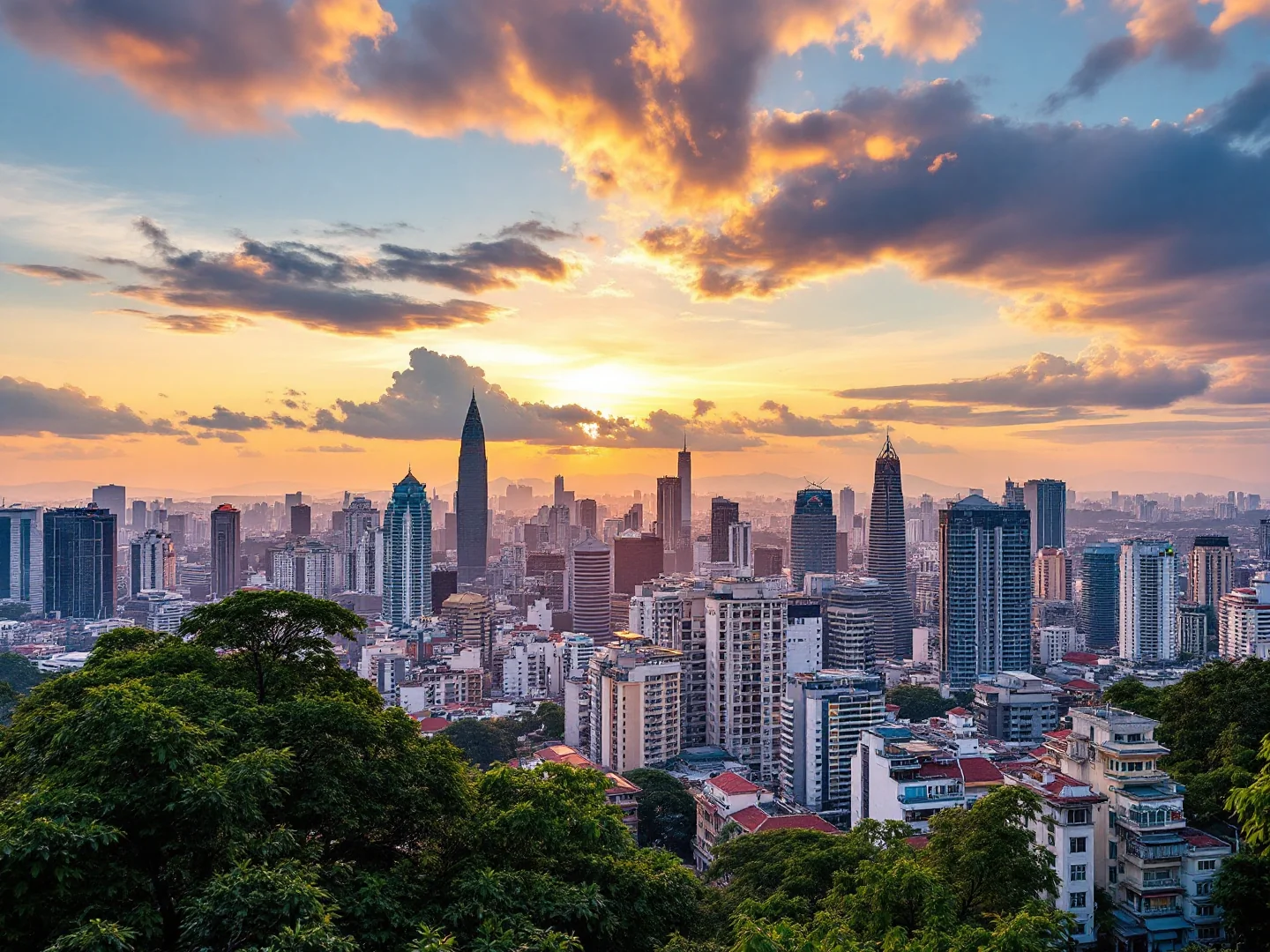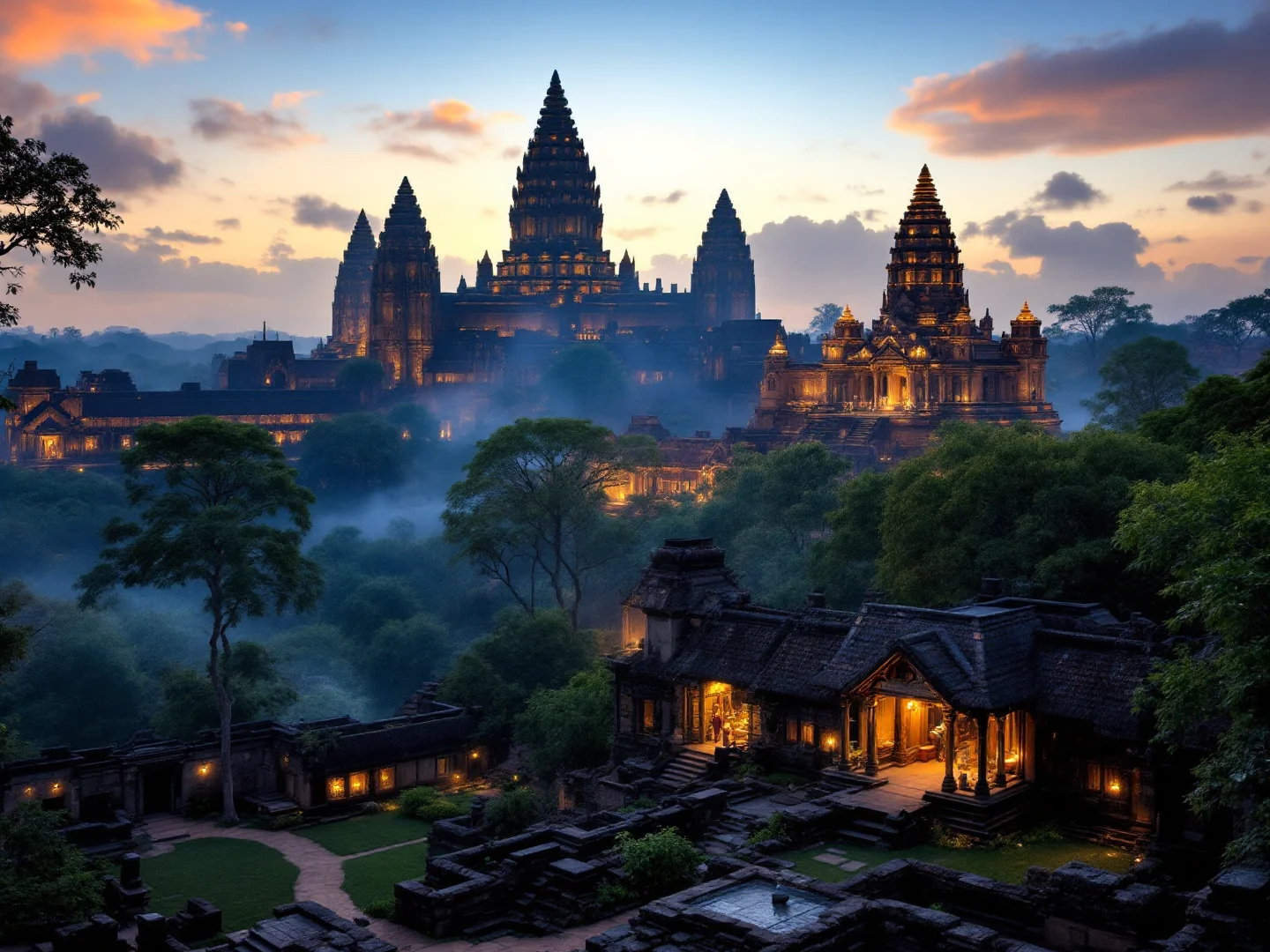Why Visit Colombo?
Colombo pulses as Sri Lanka's commercial heart where tuk-tuks weave through chaotic traffic between British colonial-era buildings in Fort district, Buddhist temples with reclining Buddhas stretching 15 meters, and Galle Face Green's oceanfront promenade where locals fly kites and eat isso wade (spicy shrimp fritters) as Indian Ocean sunsets paint skies orange. The capital (pop. 5.6 million metro) serves mostly as gateway to Sri Lanka's beaches, tea country, and wildlife, yet rewards a 1-2 day stopover with its blend of Portuguese-Dutch-British colonial legacy, Tamil and Sinhalese Buddhist-Hindu culture, and emerging modern skyline exemplified by the Lotus Tower's 356m pink petals.
Fort neighborhood clusters colonial architecture—Old Parliament, Dutch Hospital (converted to shopping-dining complex), and Grand Oriental Hotel where writers like Chekhov stayed—though much feels worn compared to Galle's better-preserved Dutch fort (90km south). Pettah Market's chaos defines local Colombo: narrow lanes burst with fabric stalls, spice vendors, electronics shops, and fruit carts navigated by pedestrians dodging motorcycles in a sensory assault of honking horns, curry smells, and hawker calls. Yet Colombo calms in pockets: Gangaramaya Temple's eclectic Buddhist complex displays gilded Buddhas, a small museum of gifts received, and a relic chamber, while nearby Seema Malaka temple floats on Beira Lake's placid water.
Viharamahadevi Park provides green respite, and Independence Square's colonial-style Independence Memorial Hall recalls 1948's end to British rule. Galle Face Green, Colombo's beloved beach promenade, attracts evening crowds: families picnic, lovers stroll, and food vendors fry isso wade and kottu roti (chopped flatbread stir-fry) while cricket games unfold on the lawn. The food scene surprises: hoppers (bowl-shaped fermented pancakes) with coconut sambol and egg for breakfast at Ministry of Crab, string hoppers and curry at local spots, and kottu everywhere.
Modern Colombo emerges in Colombo City Centre mall, Dutch Hospital's boutique dining, and rooftop bars like Smoke & Bitters. Day trips reach beaches (Negombo 40min north, Mount Lavinia 30min south), Pinnawala Elephant Orphanage (2hrs), or start the journey to Kandy (3hrs), Ella (6hrs by train), or southern beaches (Galle 2hrs, Mirissa 2.5hrs). With visa-on-arrival for most ($50 ETA online), English widely spoken (colonial legacy), and budget-friendly prices (meals $2–$5 tuk-tuks $1–$3), Colombo delivers a manageable introduction to Sri Lanka before heading to the island's more dramatic beaches, tea plantations, and wildlife parks.
What to Do
Colonial Heritage & Temples
Fort District Colonial Architecture
Colombo's business heart preserves British-era grandeur—Old Parliament building, Dutch Hospital (converted to boutique shops/restaurants), Grand Oriental Hotel where writers like Chekhov stayed. Free to wander but worn compared to Galle. Best early morning (6-8am) before traffic chaos. Grab coffee at Dutch Hospital courtyard cafés.
Gangaramaya Temple Complex
Eclectic Buddhist temple (Rs 300/$1 entry) mixes Sinhalese, Thai, Indian architecture with fascinating museum of gifts received—vintage cars, porcelain, even a throne. Resident elephant in courtyard. Relic chamber holds sacred artifacts. Go early morning (6-7am) to see monks chanting. Modest dress required—cover shoulders/knees.
Seema Malaka Floating Temple
Stunning wooden temple floating on Beira Lake, designed by Sri Lanka's famous architect Geoffrey Bawa. Connected to Gangaramaya by short walk. Sunset (5:30-6pm) creates magical reflection photos. Free to enter from temple side or view from lakeside park. Peaceful escape from Colombo chaos—feed fish, watch kingfishers hunt.
Markets & Authentic Local Life
Pettah Market Sensory Overload
Colombo's chaotic wholesale market—narrow lanes crammed with fabric stalls (Main Street), spice vendors (1st Cross Street), electronics, fruit, everything. Overwhelming but thrilling authentic experience. Go morning (8-11am) for best energy. Watch bags from pickpockets. Bargain hard (start 50% of asking price). Exit via Red Mosque (beautiful colonial-era mosque, non-Muslims can view exterior).
Manning Market & Local Produce
Main wholesale produce market, now in a newer complex outside central Pettah—where locals actually shop (not tourist trap). Ground floor has vegetables, tropical fruits (try wood apple, rambutan), fresh fish. Upper floor sells spices cheaper than tourist shops—cinnamon, cardamom, curry powders. Morning (7-10am) freshest. More functional than photogenic but authentic Colombo life.
Galle Face Green Evening Street Food
Kilometer-long oceanfront promenade becomes social hub evenings (5-9pm)—families picnic, lovers stroll, vendors fry isso wade (spicy shrimp fritters, Rs 100-150) and kottu roti (chopped flatbread stir-fry, Rs 300-500). Kite flying, cricket games on lawn. Sunset (around 6pm) magical. Old Galle Face Hotel for colonial-era drinks (expensive but atmospheric).
Sri Lankan Food Essentials
Rice & Curry Experience
Sri Lankan staple—steamed rice with 5-10 curries, dhal, sambols, papadum. Lunch restaurants (buth kade) offer Rs 200-400/$1–$1 all-you-can-eat. Try Upali's or Palmyrah for tourist-friendly versions (Rs 600-1,000). Locals eat with right hand—left for bathroom. Start small portions, most curries spicy. Ask for 'not spicy' (apita tika tika).
Hoppers for Breakfast
Bowl-shaped fermented rice pancakes—crispy edges, soft center. Egg hopper (Rs 80-120) has egg cooked inside, string hoppers (Rs 150-250) are steamed noodles with curry. Find at street hopper stalls (look for 'appa'/'hoppers' signs), Hotel de Pilawoos, or small local cafés around Kollupitiya/Bambalapitiya. Morning only (6-11am)—sold out fast on Sundays.
Kottu Roti Performance Food
Chopped flatbread stir-fried with vegetables, egg, and meat while vendor rhythmically chops on hot griddle—delicious and entertaining (Rs 300-600). Galle Face vendors best atmosphere, Hotel de Pilawoos famous among locals. Vegetable kottu lighter than mutton. Order 'medium spicy' first time. Pairs with fresh lime juice.
Gallery
Travel Information
Getting There
- Airports: CMB
Best Time to Visit
December, January, February, March
Climate: Tropical
Weather by Month
| Month | High | Low | Rainy days | Condition |
|---|---|---|---|---|
| January | 31°C | 23°C | 8 | Excellent (best) |
| February | 32°C | 24°C | 8 | Excellent (best) |
| March | 32°C | 25°C | 11 | Excellent (best) |
| April | 31°C | 25°C | 25 | Wet |
| May | 30°C | 26°C | 31 | Wet |
| June | 29°C | 26°C | 27 | Wet |
| July | 29°C | 25°C | 30 | Wet |
| August | 29°C | 25°C | 26 | Wet |
| September | 28°C | 25°C | 30 | Wet |
| October | 29°C | 25°C | 28 | Wet |
| November | 29°C | 24°C | 21 | Wet |
| December | 29°C | 23°C | 21 | Excellent (best) |
Weather data: Open-Meteo Archive (2020-2024) • Open-Meteo.com (CC BY 4.0) • Historical avg. 2020–2024
Budget
Excludes flights
Visa Requirements
Visa required
💡 🌍 Traveler Tip (November 2025): Plan ahead: December is coming up and offers ideal weather.
Practical Information
Getting There
Bandaranaike International Airport (CMB) is 32km north near Negombo. Express bus (No. 187) to Colombo Fort Rs 130-200/$0–$1 (1.5hrs). Trains Rs 150-300/$0–$1 (1hr, infrequent, crowded). Taxis Rs 3,000-4,000/$10–$13 (45min-1hr, use airport prepaid counter). PickMe/Uber apps often slightly cheaper Rs 2,500-3,500/$8–$11 Most stay first night in Negombo (airport beach town, 20min) or Colombo, then train/bus south. Colombo is hub for trains to Kandy, Ella, Galle.
Getting Around
Buses: cheap (Rs 20-100/$0–$0), crowded, slow, confusing for tourists. Trains: scenic routes to Kandy (Rs 180-400/$1–$1 3hrs), Ella (Rs 300-1,000/$1–$3 7hrs), Galle (Rs 200-600/$1–$2 2-3hrs). Book ahead. Tuk-tuks: negotiate (Rs 200-600/$1–$2 short trips) or use PickMe app (Rs 150-400/$0–$1 metered). Uber works too. Walking: traffic crazy, sidewalks poor, distances large. Colombo not walkable overall. Tuk-tuks + trains for most travelers.
Money & Payments
Sri Lankan Rupee (LKR, Rs). Exchange rates fluctuate: roughly $1 ≈ 350-360 Rs, $1 ≈ 330-340 Rs (check current rates on XE or Wise before travel). ATMs everywhere (withdraw max—fees add up). Cards accepted at hotels, upscale restaurants, malls; cash needed for street food, tuk-tuks, markets. Carry cash. Tipping: 10% restaurants if no service charge, round up tuk-tuks, Rs 100-200 for guides/drivers. Bargaining expected for tuk-tuks, souvenirs, not food. Very affordable—meals Rs 500-2,000.
Language
Sinhala and Tamil are official. English widely spoken—colonial legacy, tourism, education. Signs often trilingual (Sinhala/Tamil/English). Young people, hotel staff, restaurants speak good English. Older generation less fluent. Communication easy in Colombo and tourist areas, trickier in rural areas. Basic Sinhala: Ayubowan (hello), Sthuthi (thank you). English communication effortless in Colombo.
Cultural Tips
Buddhist culture: remove shoes and hats at temples, dress modestly (cover shoulders/knees), don't pose with back to Buddha statues (disrespectful, arrestable!). Modest dress for women reduces attention. Bargaining for tuk-tuks essential (quote 2x fair price, settle at half). Touts at bus/train stations—firm 'no' works. Tipping appreciated but not mandatory. Eat with right hand (left for bathroom). Don't touch people's heads. Stray dogs everywhere—don't pet (rabies risk). Elephants: avoid rides/shows (cruel). Traffic: pedestrians have no rights—cross very carefully. 'Island time' pace—patience essential. Sri Lankans friendly, curious about foreigners. Smile goes long way. Sunday is quiet (shops/restaurants may close early). Heat/humidity: dress light, hydrate constantly.
Perfect 2-Day Colombo Stopover
Day 1: Temples & Colonial Fort
Day 2: Markets & Modern Colombo
Where to Stay in Colombo
Fort
Best for: Colonial buildings, business district, hotels, Dutch Hospital, starting point, central but sterile
Pettah
Best for: Chaotic markets, authentic local life, spices, fabrics, street food, overwhelming, real Colombo
Galle Face
Best for: Oceanfront promenade, sunset views, street food, kite flying, relaxed, popular with locals
Cinnamon Gardens
Best for: Upscale residential, embassies, parks, museums, quieter, leafy streets, Viharamahadevi Park
Frequently Asked Questions
Do I need a visa to visit Sri Lanka?
What is the best time to visit Colombo?
How much does a trip to Colombo cost per day?
Is Colombo safe for tourists?
Should I spend time in Colombo or go straight to beaches?
Popular Activities
Top-rated tours and experiences in Colombo
Ready to Visit Colombo?
Book your flights, accommodation, and activities






